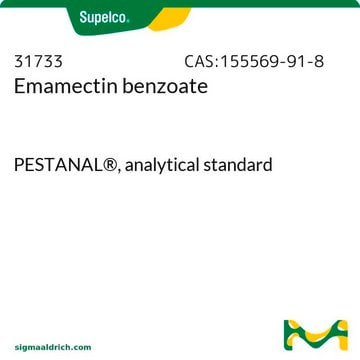I8898
Ivermectin
Synonym(s):
22,23-Dihydroavermectin B1, MK-933
About This Item
Recommended Products
form
powder
solubility
MEK: 50 mg/mL
antibiotic activity spectrum
parasites
application(s)
agriculture
environmental
mode of action
cell membrane | interferes
originator
Merck & Co., Inc., Kenilworth, NJ, U.S.
storage temp.
2-8°C
SMILES string
[H][C@@]1(O[C@]2(CC[C@@H]1C)C[C@@H]3C[C@@H](C\C=C(C)\[C@@H](O[C@H]4C[C@H](OC)[C@@H](O[C@H]5C[C@H](OC)[C@@H](O)[C@H](C)O5)[C@H](C)O4)[C@@H](C)\C=C\C=C6/CO[C@]7([H])[C@H](O)C(C)=C[C@@H](C(=O)O3)[C@]67O)O2)[C@@H](C)CC
InChI
1S/C48H74O14/c1-11-25(2)43-28(5)17-18-47(62-43)23-34-20-33(61-47)16-15-27(4)42(26(3)13-12-14-32-24-55-45-40(49)29(6)19-35(46(51)58-34)48(32,45)52)59-39-22-37(54-10)44(31(8)57-39)60-38-21-36(53-9)41(50)30(7)56-38/h12-15,19,25-26,28,30-31,33-45,49-50,52H,11,16-18,20-24H2,1-10H3/b13-12+,27-15+,32-14+/t25-,26-,28-,30-,31-,33+,34-,35-,36-,37-,38-,39-,40+,41-,42-,43+,44-,45+,47+,48+/m0/s1
InChI key
AZSNMRSAGSSBNP-XPNPUAGNSA-N
Gene Information
human ... ABCB1(5243) , CYP3A4(1576)
mouse ... Abcb1a(18671) , Abcb1b(18669)
Looking for similar products? Visit Product Comparison Guide
General description
Application
- in Caenorhabditis elegans fecundity assay
- in larval development test
- to measure in vivo topical acaricide activity of compounds in rats
- to assess its acute and chronic effects to zebrafish
- in percutaneous drug injection method to treat cystic echinococcosis
- in liquid chromatography with fluorescence detection method
Biochem/physiol Actions
Features and Benefits
Other Notes
signalword
Danger
Hazard Classifications
Acute Tox. 1 Oral - Acute Tox. 3 Dermal - Aquatic Acute 1 - Aquatic Chronic 1 - Carc. 2 - Repr. 1B
Storage Class
6.1A - Combustible acute toxic Cat. 1 and 2 / very toxic hazardous materials
wgk_germany
WGK 3
flash_point_f
Not applicable
flash_point_c
Not applicable
ppe
Eyeshields, Faceshields, Gloves, type P3 (EN 143) respirator cartridges
Certificates of Analysis (COA)
Search for Certificates of Analysis (COA) by entering the products Lot/Batch Number. Lot and Batch Numbers can be found on a product’s label following the words ‘Lot’ or ‘Batch’.
Already Own This Product?
Find documentation for the products that you have recently purchased in the Document Library.
Customers Also Viewed
Our team of scientists has experience in all areas of research including Life Science, Material Science, Chemical Synthesis, Chromatography, Analytical and many others.
Contact Technical Service















